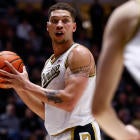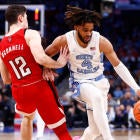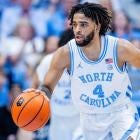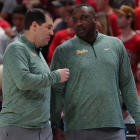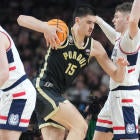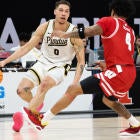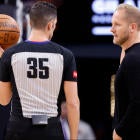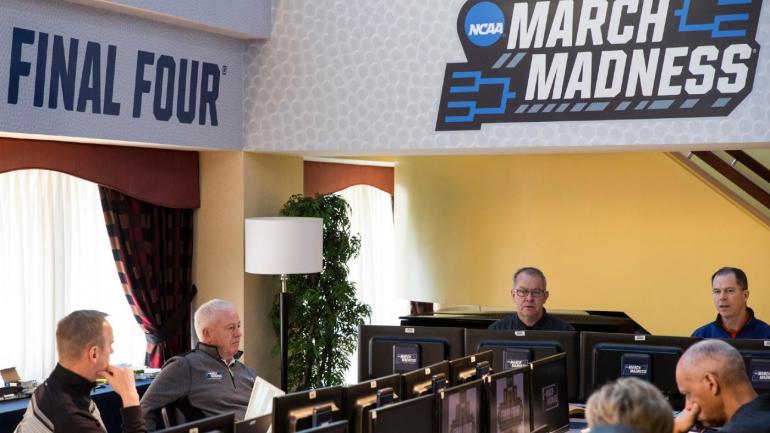
It has become an annual staple to have a pre-March Q & A with the chair of the Division I Men's Basketball Committee. This season that person is Kentucky athletic director Mitch Barnhart. Below, we dig into a lot of the most profound and urgent issues facing the committee this year. The interview has been edited and condensed for clarity and conciseness.
CBS: How much of a strain are bracketing principles on S-curve ideology, particularly in a year where we could ultimately have five teams from the Big Ten and/or Big 12 competing for top 20 overall seeding?
MB: If you have a 4-5/12-13 matchup on the S-curve, and 4 and 5 are both Big Ten teams and then you move that to the next possible spot would be the No. 3 seed, and that is also a conference opponent, then you have to go to the 2, and all of a sudden you've got something that doesn't look like the S-curve. And that is complicated. So you've got multiple teams from the Big Ten, you've had three teams from the SEC in the top 16. And then you had opportunities for them to bump into one another, and that changes the S-curve, so yeah it's, that's also another reason why this early reveal and the use of the S-curve and the bracketing principles was a really good thing to take a look at as we went through the process last week. We were certainly interested to see if we plugged in a mock field the rest of the way how that played out, and we didn't have as many complications, but it certainly is going to challenge us. It's not going to be a perfect S-curve.
CBS: We almost never see teams one or two wins above .500 receive at-large inclusion, but given how you're tracking the sport now, do you think it's reasonable to forecast there could be teams right near .500 that wind up making the field?
MB: Hard for me to speculate on that. As I said Saturday [on CBS], there's 1,000 games left and almost all those will be conference games. There are leagues that chose to spend more of their games in-conference this year -- and some were totally in-conference. For the leagues that have traditionally been multi-bid leagues, their résumé will primarily be their conference games, and they may be 10-8, 11-11 or 10-10. That could be a factor where we're having to evaluate those teams that's close to .500 and again, it goes back to a little bit about who you beat, where'd you beat them, opportunities for quality wins and did you take advantage? Those are all important details. The ability to look at common opponents and if there's head-to-heads -- there might be some -- but we lost a lot of nonconference opportunities and that's certainly going to factor into the smaller résumés to the committee. I don't want to get into how that might play out in real time, but I certainly think it will have an impact in our ability to evaluate teams across the board.
CBS: How is the committee grappling with this inevitability of vastly different game totals at the end of the season? One team might wind up having nine or 10 more results than another under consideration in a similar spot. Is that an advantage or disadvantage?
MB: I don't know that there is a real clear answer on that. It is new territory and clearly every committee member is going to have to look at it through the prism with which they see it. We've had conversations about how difficult that's going to be. Take Saint Louis for example. They've got a high-quality win over LSU out of conference. Then all of a sudden they're put in a position where they've not played many conference games and been put on pause, or someone else's put them on pause in their schedule. Minnesota has played a pretty full schedule of 21 games, struggling to win on the road, what does that mean to their total résumé as it relates to teams that haven't had the opportunity to go on the road? Those are great conversations. No one will be penalized for being on pause. Sometimes it just doesn't work and we'll do the best we can at trying to find a way to across the span of games to try and find some commonalities and some things that give you a chance to measure one against the other. And ultimately find the 37 at-larges that give you the best field.
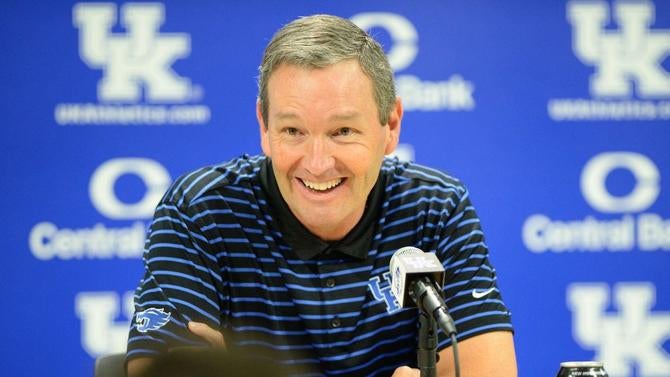
CBS: Because of the way the schedules were built out this season, with back-to-backs, it's put a magnifying glass on the somewhat-random nature of a single-game results. Has that expanded your thinking on not potentially relying on one or two specific results when it comes to weighing one team vs. another for seed or at-large inclusion?
MB: I think that affects everything from preparation, rest and recovery, scouting. I think it's in everybody's mind that this is a way different environment. This is not something we're used to. [Back-to-backs] are unique experiences and it's changed an awful lot. I'm curious and will go look back at it: how many times you have back-to-back games against the same opponent and they're split? We're going to find out.
CBS: What about teams like Belmont (22-1) and Winthrop (18-1)? Through zero fault of their own they lost many high-level opponents because of COVID that they were otherwise guaranteed to play. They're both currently in the 60s in the NET -- not terrible, not amazing. Would you support the committee having long, objective discussions about the consequences programs like these have faced if they wind up not getting automatic bids?
MB: Clearly they're having really remarkable seasons and that's a tribute to their programs. I would say, arguably, we always have long, objective conversations about the teams that present these kinds of résumés and sometimes they don't have the opportunities at the [major-conference level]. I obviously will continue to support objective, long conversations about these very complicated, these very pieces that you raised. I think they are certainly absolutely worthy of conversations, as many teams are, but I will absolutely support an objective look at making sure that we give them every consideration, should they not prevail in their conference tournaments, that they're given every consideration for an at-large position. And I don't think that there's a committee member in there that wouldn't want to do that.
CBS: So if a Belmont or Winthrop are held back by the metrics to an extent -- despite really good records -- it would be fair to say the committee will not hold their circumstances against them because they did not play good nonconference schedules through zero fault of their own?
MB: There's nothing that says that metrics automatically disqualify anybody. You come with a record and your résumé. Those are all evaluated and the metrics are just merely one piece of the evaluation process. You've heard it said many times: there's many tools in the toolbox; that's one of them. But that's not the only one that the committee uses.
CBS: How many hours per week do you personally dedicate to your job as committee chair, be it through watching games, being in meetings, evaluating data? Ballpark it.
MB: Every night is basketball night at our house. The part that is hard to get your arms around is the other pieces in terms of preparation. I give the staff an awful lot of credit. What they're doing is unbelievable. It's my 24th year as an athletic director and I've been on a lot of committees. I've never seen a group work this hard. The NCAA staff, what they are trying to get done is Herculean. I can't tell you how much Dan Gavitt and his staff have put into this. For me to sit here and act like we're doing the work as a committee, when they're doing the work, would be inappropriate. It is almost in honor of what they're pulling off. And I don't ever say that lightly. It is. If we can get to the championship night and raise a trophy for someone, it'll be one of the great feats of operational organizational things I've ever seen done. So, my absolute compliments to them. I'd say I'm probably spending, oh, six, eight hours a day. I don't know. I never really thought about it, to be honest with you. It's another full-time job and it's not even a job because you enjoy it.
CBS: The NCAA put out a statement regarding conference tournaments last week. It seems most will play in league tournaments. But Mark Few has been on-record saying he would prefer not to play in Las Vegas. Are we at the point that if a league holds its tournament but then a surefire tournament team decides not to play that the selection committee is effectively powerless? It has to accept if the WCC or another league were to do that?
MB: Tournament participation is local decision making. I will tell you that we value participation and we encourage it. I think that honors the game, and a lot of people have made unbelievable efforts to get to play this year. And I think that honors their efforts, whether that's student-athletes, that's medical staffs, that's operational people putting things in place that give us a chance to play the game. I think the participation honors that. Having said that, the other piece that I think is really important is that that kind of participation gives a committee the fullest evaluation for selection and seeding and bracketing that are important to us. And so I think each person is going to have to weigh that, and I would hope that they would honor their tournaments and their games in a way that they see fit. I think that our statement was pretty clear there, but it is local decision making.
CBS: How far along is the committee with any and all bracket contingencies? When will we know more and is there anything you can share right now?
MB: Not just yet I can't. But I will say we've had significant conversations and spent a lot of time last week talking about contingencies. Prior to the bracket being announced, post bracket being announced, obviously the women's tournament has got similar conversations going on with regard to their tournament and we may be syncing those up. They may be unique to each tournament, but I think that there'll be some collective conversation with the staffs and committee chairs. Hopefully, obviously sooner rather than later so there can be some clarity, I would hope to hear in the next week or two that we can finalize all that.
CBS: Even though you can't reveal anything right now, when you speak about these contingencies, we are talking all potential scenarios, yes? From a team that is out the Wednesday before the first round to what happens if we lose one of the Final Four teams the day before the semifinals?
MB: There's decision trees or whatever you want to call them. Pyramids, flowcharts that we'll have to work our way through. That's why it's complicated, because there's not just one decision, one size fits all. "How you do it right here, that's how it's done for the rest of the tournament." There's going to be multiple conversations and multiple decisions that have to be made, and we've got to be prepared as best we can, realizing that they might not all fit every scenario. So that's where we are.
CBS: When will we know the fan-allowance policy for every round of the tournament and with specific venues?
MB: We don't have an answer just yet. We're working our way through the attendance conversation with each of the county health organizations and local health officials. Certainly we would love to have fans in the stands to provide some atmosphere for the young people that are playing and we'd like to have it at as many venues as we possibly can. And so, generally, if you've been watching nationally places that have it, it's usually been in that 15-25% range. At our place, Rupp Arena, we've been at 13-18%. We're hopeful to get folks in the venues to be able to watch college basketball in March, and hopefully that answer will be forthcoming pretty quickly because there's a lot of folks that would like to be able to make their plans to be in the facilities.
Dominant Belmont deserves more room for error
At 22-1, Belmont has the most wins in college basketball and looks the part of an NCAA Tournament team … except if you check the metrics. The Bruins are lingering in the high 60s in the NET, in the high 70s at KenPom and are as low as 84th in Sagarin. Those aren't at-large-friendly numbers. At least there's Strength of Record (SOR), arguably the fairest of the six major metrics on NCAA team sheets. SOR has the Bruins respectably placed 41st. Should it fail to win the Ohio Valley auto bid, SOR, a likely gaudy record and a realistic discussion about what Belmont had taken from it this season are the three things that this team can hope for.
Bruins coach Casey Alexander isn't gripping yet. But that feeling in his gut is probably arriving soon enough. When you're a mid-major and you've got a brassy record but not one top-100 win, history suggests you have almost no room for error.
"It's building, I don't think I'm there yet," Alexander told me this week. "I really trust that our team is not there yet, because we've just been trying to put one foot, and one week, in front of the other. But it's getting closer, and there's more conversations like these, so you feel it building a little bit."
If Belmont takes a second loss (god forbid a third) and doesn't win the OVC, it'll be in danger of getting shipped to the NIT. Circumstances surrounding Belmont's schedule need to be taken into the account, particularly because it's been such a dominant team. (Margin of victory should matter, to an extent, beyond just wins and losses.) Belmont is wrecking opponents by 18.6 points in league play. The Bruins have had just four games decided by single digits. Their 10 road wins lead the sport, with two more opportunities still to come. Belmont ranks second in the nation in effective field goal percentage and 2-point accuracy. The only team better is No. 1 Gonzaga, which joins Belmont as the only other team to win 34 out of its last 35 games.
"We've played really well by any measure you want to take as far as efficiency and margin differential. It''s kind of unmistakable that we found a little bit of a groove here," Alexander said.
Here's a quick primer on the elements out of Belmont's control that have hindered its ability to rise in the metrics despite winning 22 out of 23 games, most of them in commanding style. The Bruins were slated to play in a good November multi-team event, the Orlando Invitational. When initially assembled (before COVID-19 dissolved every ESPN MTE in Orlando), that MTE boasted projected and/or potential tourney teams Gonzaga, Xavier, Saint Louis and Boise State. The other three: Auburn, Michigan State and Siena, which has a case as a top-10 mid-major this season. It was a cherished opportunity for Belmont to get an invite to an event like that. Then it went up in smoke.
With the regular season dropping from 31 to 27 games, Belmont also had USC, Western Kentucky and Duquesne games get canceled. Would Belmont have won all? Certainly not, but it could have potentially earned one or two key Quad 1 and/or Quad 2 wins, boosting its credentials in the process and leaving less room for interpretation or guesswork. Instead, Belmont was left to its own devices and eventually had to settle on a four-team MTE in Washington that included a game vs. a Division II school.
"We just did the best we could to make the best decisions we could at the time because we need the games, playing for playing for strength of schedule was not part of our equation in any way shape or form at that point in time," Alexander said.
Alexander said the difficulties surrounding the opening three games -- it barely practiced in the lead-up -- is "by far the biggest reason why we are where we are right now."
The Bruins bussed 22 hours roundtrip, masked the entire time, with only one bathroom break each way. All that to get in two countable games almost 700 miles away and with nine players available. Question is: Will the committee respect Belmont when its strength of schedule ranks 343 (out of 346 teams this season), according to the NET?
"It's remarkable to me how the conversation in November and December was, on a national scale, no matter who you asked: this is a different year," Alexander said. "It's a COVID year. It's gonna be different, it's gonna look different, we're gonna have to measure things differently based on the data that we have. And now here we are, a couple of weeks out from Selection Sunday and it's, 'What's their NET? What's their strength of schedule? What's their Quad 1 wins? There's no mention of anything that might have affected any of those things, so that's really concerning to me."
Belmont played its first five games without a full roster. Its lone loss -- an abysmal one at home to Samford that hangs like an albatross around this team's proverbial neck -- was the first day the entire team was together.
It's imperative the committee looks into situations of teams like Belmont (and 18-1 Winthrop) to understand the opportunities taken from them because of the pandemic. If Belmont winds up, say, 26-2 but loses in the OVC semifinals there should be almost no debate about its worthiness of getting an at-large. There's never been a two-loss at-large team held out of the field. Should Belmont or Winthrop find themselves in that spot after logging at least 25 games, it would be a tough sell to set a new precedent in this unprecedented season.

Gonzaga can be rare team that never loses No. 1
No. 1 Gonzaga sits at 20-0, its two most recent wins against BYU and San Francisco highly increasing the likelihood that the Bulldogs will not lose a game this regular season. Barring scheduling a quality nonconference opponent after its WCC slate is complete, Gonzaga has an 96.6% chance to not lose prior to postseason play, according to KenPom.
If and when Gonzaga gets to Selection Sunday without a loss, it would mean the Bulldogs went wire to wire at No. 1 in the AP Top 25. Should that happen, it would mark the first time since 2014-15 Kentucky that a team that was the preseason No. 1 held that spot every week of the season. Gonzaga would be the 14th team in history to stay at No. 1 the entire season according to College Poll Archive. If GU does it, it would also ensure the 2020s to have at least one instance of this, meaning the 1980s is the only decade since the 1950s to not have at least one season in which a team was wire-to-wire No. 1.
@ me
Each week I highlight reader questions, so find me on Twitter and @ me with whatever!
What does Michigan State need to do to make the NCAA Tournament?
— Mike Phillips (@MPhillips331) February 11, 2021
Win the Big Ten Tournament. Michigan State has no path to get an at-large at this point.
You have to put $100 on a team to make the title game, and you can't choose Baylor/GU/MI/IL/tOSU - which team would you pick?
— ltownZag (@LtownZag) February 11, 2021
I guess I just can't quit Virginia. Four 3-point shooters above 40% and an offense that -- you might not believe this -- actually rates better than its defense as of today. We know that D will show up in the NCAAs. UVA would be my top pick to win five this March.
Will current seniors that decide to take advantage of NCAA extending another year of eligibility be able to transfer freely? Or are they restricted to staying at their current school if they want to use the extra year of eligibility?
— Max Jakubowski (@AirMax11267) February 11, 2021
The rule as of now is a player must remain with his current program to be able to play that bonus year next season. How this will or won't change based on transfer legislation that is expected to be on the books later in 2021 remains unknown. But it is very much a situation worth monitoring this spring when there will be some mid-majors who could capitalize on this for a big season in 2021-22.
Sports have struggled ratings wise since the pandemic began
— BJ Walters (@WaltersVoice89) February 11, 2021
Is an undefeated Baylor vs undefeated Gonzaga national championship game what brings sports back in a big way?
The NCAA Tournament is in a different category from every other major American sporting event because college basketball is the only major American sport that did not hold a championship event in 2020. So, weirdly, the fact that this year's tournament is going to be void of blue bloods combined with the American public being deprived of brackets for two years serves as a reason to emotionally invest. If you were ever going to have a year without Duke, Kentucky, Michigan State, Arizona and potentially some other top 15 all-time schools, this is the year. To answer your question, there is no better scenario for college basketball than to have Gonzaga and Baylor make it to the title game and both be undefeated. It would be gargantuan.
Y'all know your history. How many teams have just strolled through the NCAA tourney as easily as the '09 UNC championship team? Average margin of victory 20 points.
— Jesse White (@LuckyBeerCamper) February 11, 2021
I got your goodies for ya. The only teams to have a win margin of at least 20.0 points and play six games in the NCAA Tournament are 1996 Kentucky (21.5), 2009 North Carolina (20.2) and 2016 Villanova (20.7). Five other teams did this before the tournament expanded in 1985: 1963 Loyola Chicago (23.0), 1967 UCLA (23.8), 1968 UCLA (21.3), 1979 Michigan State (20.8) and 1981 Indiana (22.6). More: 2018 Villanova (17.7) is one of four teams ever (along with 1952 Kansas, 1960 Ohio State and 1968 UCLA) to win all of its games by at least 16 points. In fact, since the field expanded in 1985, the only four teams to win all six games by double digits are 2000 Michigan State, 2001 Duke, 2009 North Carolina and '18 Villanova.
Final shots
• Important story: Noah Freidel is South Dakota State's most important player. But he's stepping away for the rest of the season because of depression and anxiety. There is no shame in this decision. Hopefully he can work through it, come out stronger, happier and return to college basketball to flourish whenever he is ready.
• There's been some mixed reporting regarding the NIT in recent days. Here's what sources have been telling me in the past week-plus. The field is shrinking from 32 to 16 teams. Selection criteria is being modified for this year. ESPN and Madison Square Garden agreed to not hold the championship in that building this year and the tournament finale is moving out of New York. With the NCAA owning the NIT, there are still logistics being determined over whether it would be best, and doable, to hold the NIT in the state of Indiana this year. If that happens, the next logical step is to consider "calling up" NIT teams to the NCAA Tournament if necessary -- but only if there are selected NCAA Tournament teams that wind up being unable to play in the first round. There will be more on this in an official capacity in the next 7-10 days.
• Wednesday's scheduled Syracuse-Louisville game was postponed less than eight hours before tip. Here's the frustrating part: it was the second time in less than six weeks the teams had their game pushed on the same day they were scheduled to play it.
• Here's an unusual thing that I wonder about: North Carolina has only played seven of its 20 games at home this season. That's a rare discrepancy for a power-conference team. Are we evaluating the Heels unfairly because of it? After losing its Tuesday home tilt vs. BC for next week, it could lose its next home game this Saturday vs. Louisville as well.
• Another bubble team getting no help as of late: Colorado State. Lost two games vs. New Mexico and just lost two more vs. Nevada. Coach Niko Medved tells me they might try to get in a game against a non-DI just to keep the team's legs fresh.
• Just what college basketball didn't need: more than two dozen games have been postponed this week (including key SEC, ACC and Big 12 tilts) due to weather, with more potentially still at risk in the coming 48 hours. Plenty of them will not be made up, and it will further impact team résumés in the process. Opportunities vanishing.
• Randomly kind of cool: Two Duke basketballs sent in the '90s to then-teenager Kobe Bryant (when Duke was recruiting him) are up for auction with 10 days left. Current bid is $380. Plenty of time left to get in!
• Creative and just asking to be replicated: Ken Pomeroy is advising the WCC with an empirically fair way to seed the conference's men's and women's league tournament this year.
• As expected, the in-person recruiting dead period for all NCAA sports will go until at least May 31. I do expect the July live period to return for college basketball, and when it does, it will be a frenzy for every team in the sport.













